Music by Toshiyuki O'mori | ||
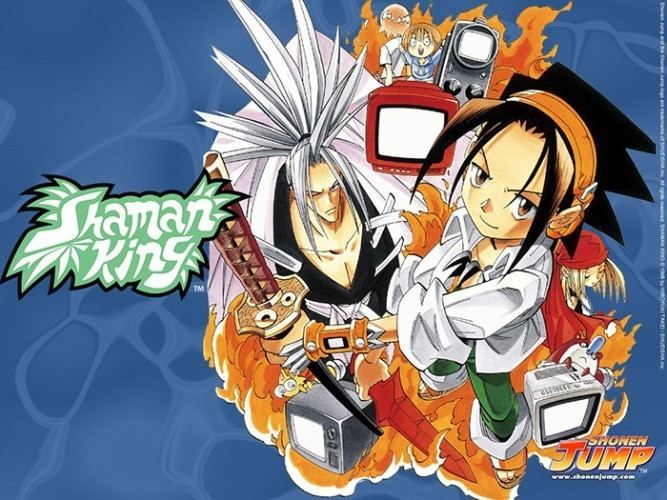 | ||
English publisher Madman EntertainmentViz Media Main characters Yoh Asakura, Hao Asakura, Horohoro, Amidamaru, Anna Kyoyama Similar Yu Yu Hakusho, Hikaru no Go, Inuyasha, Fullmetal Alchemist, Hunter × Hunter | ||
Shaman King (Japanese: シャーマンキング, Hepburn: Shāman Kingu) is a Japanese manga series written and illustrated by Hiroyuki Takei. This manga follows the adventures of Yoh Asakura as he attempts to hone his shaman skills to become the Shaman King by winning the Shaman Fight. Takei chose shamanism as the main theme of the series because he wanted a topic that had never been attempted before in manga.
Contents
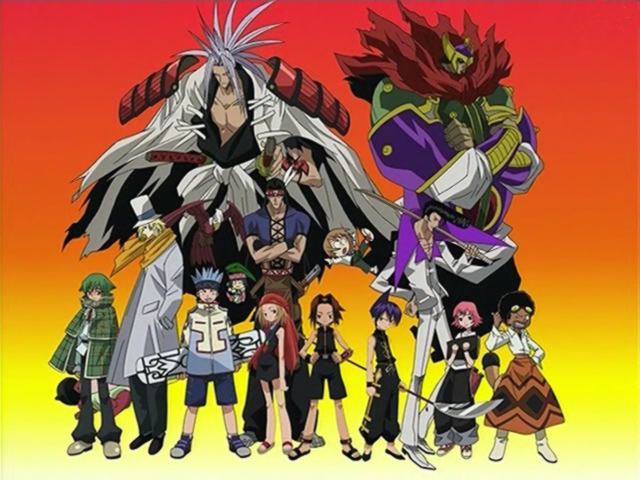
The Shaman King manga was originally serialized in Weekly Shōnen Jump between 1998 and 2004. The individual chapters were collected and released in 32 tankōbon volumes by Shueisha. An animated television series was co-produced by TV Tokyo, NAS, and Xebec, which aired on Japan's TV Tokyo network from 2001 to 2002. The manga has also been reprinted in a kanzenban edition, and has spawned video games, a trading card game, and many types of Shaman King-related merchandise.
In North America, Viz Media obtained the English-language license for the manga and published chapters of Shaman King in its Shonen Jump magazine from March 2003 to August 2007. The anime series was licensed in North America by 4Kids Entertainment in 2003, and aired on Fox Box. Exclusive video games were released by 4Kids Entertainment in North America and Europe.
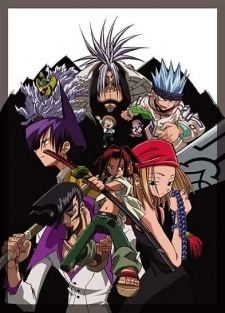
In Japan, the manga has been popular, selling over 26 million volumes. Both the manga and anime have been featured, at various times, in "top ten" lists of their respective media. The Shaman King anime has been watched by a large number of television viewers in Japan. Publications about manga, anime and other media have commented on the Shaman King manga, with positive comments on the series.
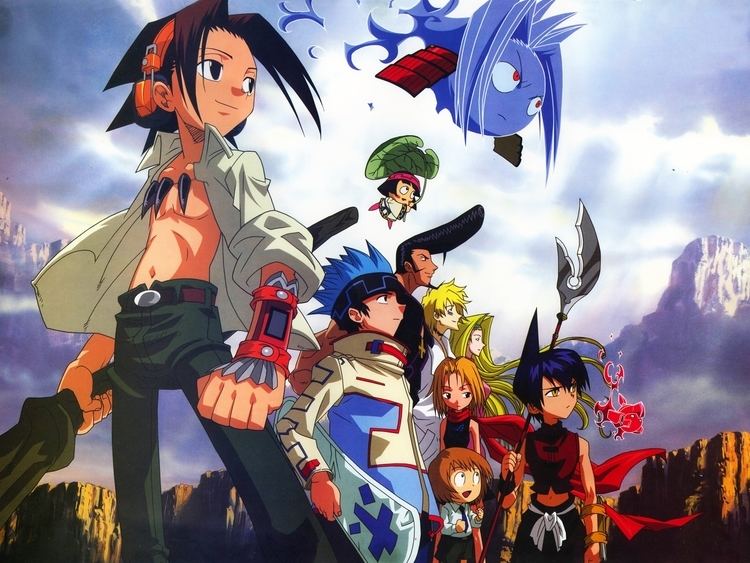
Plot
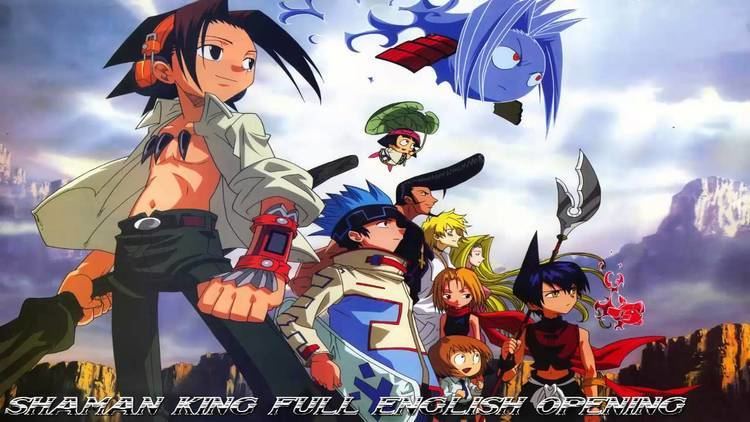
The plot of Shaman King revolves around Yoh Asakura, a shaman, a medium between the worlds of the living and the dead. Yoh seeks to become the Shaman King, the one who is able to contact the Great Spirit, and will gain the ability to reshape the world in any way they wish, and for this purpose he must to win the Shaman Fight, a battle held once every 500 years between competing shamans. Anna Kyoyama, Yoh's fiancée, soon enters the scene and prescribes a brutal training regimen to prepare him for the tournament. Thus begins the plot that will lead Yoh on a journey that will lead him to befriend Ryu, Tao Ren, Horohoro, Faust VIII, Lyserg Diethel, and Joco McDonnell (known as Chocolove McDonnell).

During the Shaman Fight, Yoh encounters Hao Asakura, a strong shaman who wishes to eradicate humans and create a world for shamans. At the end of the shaman battles, the remaining teams consist of Yoh and his friends, the X-Laws and Hao's team. The remaining teams choose to forfeit the tournament, crowning Hao with the title of Shaman King. As Hao is led away, Yoh and his allies decide to attack Hao while he is merging with the Great Spirit, which is in a coma. To conquer Hao, Yoh and his friends must defeat The Patch Tribe members who are obligated to serve under the new Shaman King.
After Yoh and his friends overcome the ten Patch Tribe members, Hao is awakened as the new Shaman King. He defeats Yoh and all his friends and absorbs their souls. Inside the Great Spirit, Yoh, Ren, Horohoro, Lyserg, and Chocolove battle against Hao using the five legendary spirits: the Spirit of Earth, the Spirit of Thunder, the Spirit of Rain, the Spirit of Fire, and the Spirit of Wind. When former associates of Yoh and his friends begin appearing in the Great Spirit, it is revealed that the Great Spirit granted Hao's wish for someone to bring back his mother's spirit. With Anna's help, Hao's mother is brought to the Great Spirit. Hao's mother tells him that, in order to be saved, he must forgive the humans for murdering her. Hao decides to postpone his plan to eradicate humans and to observe how Yoh and his friends will change the world.
Seven years later, Hana Asakura waits at a station for the five legendary warriors and his parents, Yoh and Anna.
Production
Before creating Shaman King, Takei, an assistant of Nobuhiro Watsuki's Rurouni Kenshin, exchanged ideas about the series with the other assistants. As a colleague of Watsuki, he worked primarily as a manga assistant, only focusing on his own projects during his days off. He was influenced by street art from hip-hop and rap culture, which is apparent in his manga artwork. For drawing, he used calligraphy inks and pen nibs. When illustrating, he used Copic brand color markers.
He chose shamanism as the principal topic of the series because he wanted to choose a subject that had never been approached in manga before. He said he incorporated his own personality and beliefs in Shaman King. He has an interest in the topic, and "choosing shamanism as the subject of this story seemed like a natural extension of that." For the title, he said he used "shaman", an English word, due to the fact that "the nuance is really great" and because he could not find a Japanese word with the accurate meaning of the word "shaman". Another reason to have shamanism as the main subject was because he could explore elements from different cultures and their relationship with the dead and the spirits.
Takei created the stories after he created the characters because he believed the "stories are born because of the existence of the characters". In addition, he felt that "the most important thing [to create a character] is to have originality". Through his characters he wanted to show different cultures, backgrounds and values. When asked "how do shamans of pacifistic religions ever win the Shaman Fight?" he answered that the Shaman Fight is fought using the "strength of the soul". Takei declared "the final message of Shaman King is that fighting is no good."
Publication
The chapters of Shaman King were written and illustrated by Takei and were published in Shueisha's Weekly Shōnen Jump from June 30, 1998 to an abruptly and improvised end on August 30, 2004. The first 275 chapters were collected into 31 tankōbon volumes; the first of which was released on December 3, 1998, with the 31st being released on October 4, 2004. The release of volume 32—intended for publication on December 3, 2004—was delayed and Shueisha reported they would only publish volume 32 if they receive evidence of demand from approximately 50,000 people. The release of the last ten chapters in tankōbon format happened on January 5, 2005. A spin-off to Shaman King, Funbari Poem (ふんばりの詩, Funbari no Uta), lasted for five chapters—all of which were included in volume 32. Taking place seven years after the end of the manga series, it features Hana Asakura, son of Yoh and Anna, and his journey with Ryu to find the Five Elemental Warriors for a reunion before the opening of the Funbari Hot Springs Inn.
Takei declared it was not a decrease on the series profitability that was the reason for its cancellation, but a "fatigue" he had been through because he was no more able to follow his fans' wishes. In the author's opinion, Shaman King was being "normalized" by the desire of his readers with the introduction of typical shōnen aspects and losing its originality. In 2007 he revealed he was planning to end the series with the final he initially envisioned to be published in another Shueisha magazine in the end of the year or in the beginning of 2008. Eventually the entire series was reprinted in 27 kanzenban volumes with the title Shaman King Kanzen-Ban (or "Perfect Edition"), concluding with the "true ending" to the series. The new series finale was also posted on the official Kanzen-Ban website, in addition to the print editions. The first volume of the Perfect Edition was released on March 4, 2008, with the last (volume 27) being published on April 3, 2009. Five years after the end of the series, when the Shaman King Kanzen-Ban was finished, Takei said, "After making the readers waiting [sic] so much for this, the last thing I wanted to do was to disappoint them". He thought the ending was a "huge responsibility". This edition served to make corrections and adjustments and, for Takei, it was something "fun," as it was different from scratch.
Shaman King has also been published as part of the Shueisha Jump Remix series of magazine-style books. Sixteen volumes of Shaman King were released under the Shueisha Jump Remix series between April 1 and October 28, 2011. On November 10, 2011, a series of one-shot called "zero stories" detailing Yoh and other characters backstories started to be serialized in Jump X. In the same issue the first "zero story" was published, Shueisha announced the serialization of a sequel, focusing on Hana Asakura's development as a shaman; Shaman King: Flowers (シャーマンキング Flowers, Shāman Kingu Furawāzu) started on April 10, 2012. Both series concluded in the final issue of Shueisha's Jump X on October 10, 2014. Two volumes of Shaman King: Zero were released on May 10, 2012 and January 19, 2015 respectively. The Flowers series was compiled into six tankōbon released between August 10, 2012 and December 19, 2014.
Viz Media licensed the series for an English-language release in North America; the chapters initially serialized in the American Shonen Jump, beginning in third issue in 2003 and ceasing its serialization in the August 2007 issue. From then, it was exclusively published through graphic novel format and Viz said it was done in order to speed up the series' publication. Volume 1 was released on September 3, 2003, and volume 32 was released to conclude the series on January 4, 2011. In Australasian region, Madman Entertainment licensed and published the series between February 10, 2009 and September 10, 2011. The manga has also been licensed in some countries such as in Brazil by Editora JBC, in France by Kana, in Germany by Carlsen Comics, in Italy by Star Comics, in Norway by Schibsted Forlagene, in Russia by Comix-ART, in Singapore by Chuang Yi, in Spain by Editores de Tebeos, in Sweden by Bonnierförlagen, and in Vietnam by Kim Đồng Publishing House.
Anime
The episodes of the Shaman King anime series are directed by Seiji Mizushima and co-produced by TV Tokyo, NAS, and Xebec. At an early stage of anime production, Takei himself helped the anime's staff. However, he soon left the staff due to his time limitations as he was working in the manga. The 64 episodes were aired between July 4, 2001, and September 25, 2002, on TV Tokyo in Japan. 4Kids Entertainment obtained the rights to broadcast the Shaman King anime in the United States, where it premiered on Fox Box on September 6, 2003.
The episodes were collected into 16 DVD compilations by King Records in Japan and released between October 30, 2001, and January 22, 2003. The DVDs were later collected and released in three box sets between August 27, 2008, and December 25, 2008. Five DVD compilations of the English adaptation have been released by Funimation Entertainment between October 19, 2004 and March 29, 2005 in an uncut form.
Audio
The music for the Shaman King anime adaptation was composed by Toshiyuki Omori. Two CD soundtracks have been released for the Shaman King anime series. The first soundtrack was released on March 27, 2002, as Shaman King: Vocal Collection, and contains 14 tracks, including the first opening and ending themes in their original television lengths. Shaman King: Original Soundtrack followed on June 26, 2002, with an additional 20 tracks and the second opening theme "Northern Lights". Six character song CDs were released on March 24, 2004, sung by the voice actors as their respective characters. Three drama CDs have been produced for the series as well, featuring the original voice actors from the series.
Trading card game
A collectable card game based on the Shaman King series was produced by Tomy in Japan and released in the United States by Upper Deck in 2005. Upper Deck originally planned a mass market release of the game for January 2005, however, it was later announced that Blockbuster Video would have exclusive rights to sell the game from January 28 to February 15, 2005, after which it would be released to other retailers. In an interview with Upper Deck's Director of Brand and New Product Development, Cory Jones stated that it was the television show's underperformance and later cancellation which led to the cancellation of the trading card game.
Video games
Thirteen video games based on the Shaman King series have been released. The first one, Shaman King Chō Senji Ryakketu Funbari Hen, was released on December 21, 2001. Although the games developed in Japan have not been released outside of that region, Konami and 4Kids Entertainment developed a series of games that were only released in North America and Europe. Characters of the Shaman King series have also made appearances in the games Jump Super Stars and Jump Ultimate Stars.
Other
Two light novels with the story by Hideki Mitsui and art by Hiroyuki Takei were released on December 25, 2001, and August 23, 2002. A fanbook titled Shaman King Official Fan Book: Mankin Book (シャーマンキング公式ファンブック「マンキンブック」, Shaman Kingu Kōshiki Fan Bukku - Mankin Bukku) was released on April 30, 2004. Two guidebooks were released. The first, based on the original series and entitled Shaman King Character Book: Manjien (シャーマンキングキャラクターズブック「万辞苑」, Shaman Kingu Kyarakutāzu Bukku - Manjien), was released on June 4, 2002. The second, called Shaman King Kazenban Final Official Guide Book Mantarite (シャーマンキング完全版 最終公式ガイドブック マンタリテ, Shaman Kingu Kazenban Saishū Kōshiki Gaidobukku Mantarite), for the kanzenban version of the series, was released exactly seven years later. In Japan, various other types of merchandise were released, including key chains, action figures, clothing and other toys.
Reception
The original manga series of 32 volumes has sold over 26 million copies in Japan. The new Shaman King Kanzenban volumes have been ranked in listings of best-selling manga in Japan as well as its guidebook, both Shaman King: Zero volumes, and Shaman King Flowers first four volumes. Volumes of the series have been ranked in listings of best-selling manga in the United States such as The New York Times, Nielsen BookScan and Diamond Comic Distributors. In 2008, Shaman King was North America's 24th best manga property according to ICv2, based on sales for the entire year of 2008. The anime adaptation has also been featured several times in the Japanese TV ranking, with the last episode having a 9.5 percent television viewership rating. Shaman King was voted the sixth best anime of 2001 by Animage readers. In 2005, Japanese television network TV Asahi conducted a "Top 100" online web poll and the Shaman King anime adaptation placed 47th. Moreover, approximately 165 million cards from the Shaman King trading card game were sold in Japan.
Justin Freeman from Anime News Network (ANN) criticized the first volume for relying too heavily on the spirits as a deus ex machina, stating that is what "places the series on the wrong path." On other hand, Alexander Hoffman of Comics Village declared "in this first novel, letting the relationships between Yoh, Amidamaru, and Manta flesh out is more important that developing every spiritual entity that shows up." Holly Ellingwood of Active Anime said she was fascinated by how Takei was capable of taking several myths and cultural beliefs and "blending them into the character backgrounds". Lori Henderson of Manga Life cited the fact every character, even the villains, "has a reason for fighting" and their "internal struggles" as well as the fights itself as the main reason why make Shaman King is "an enjoyable title." A reviewer for The Star declared, praised the characters development and Takei's capacity to create "new interesting ones each volume," commending "their backgrounds and unique personalities." Writing for ANN, John Jakala commented that he was struck with the "unique", "graffiti-style" visual of the series. Although labeled its art as "silly", Sheena McNeil from Sequential Start expressed that "it's smooth and nicely detailed with excellent expressions." McNeil deemed Takei did "a wonderful job of bringing shaman into the modern day but keeping it a story of fantasy". Ellingwood stated the series' "vibrant action", "imaginative plot twists and a creative world" makes it "a unique and stylish shōnen series."
Mania's Eduardo Chavez said that, Shaman King can "hit all the right buttons one volume" but "it could be a complete bore" in the next. School Library Journal's Cathleen Baxter commented that Shaman King has "nonstop action" with "typical shōnen characters and battle styles". The storyline is "easy to follow and will hold the reader's interest." Margaret Veira of Active Anime, however, argued that the storyline gets more complex as the series progresses, while comics critic Jason Thompson commented that from volume 20 it "seemed to veer off tracks". In addition of a decline on artwork in his opinion, the numbers of fights also decreased; Thompson wrote, "their enemy ... may be unbeatable by force alone, so the plot shifts away from battles and towards unexpected betrayals, character relationships, and clever (and confusing) schemes—rather than mere fighting techniques." The last volume, especially, "may leave some readers feeling cheated," said Leroy Douresseaux from Comic Book Bin. Thompson was also disappointed by the 2004 conclusion but he wrote that the kanzenban version has "a great ending", whose "transcendental climax is not too different from Katsuhiro Otomo's Akira, or for many American comics about beings with ultimate power."
